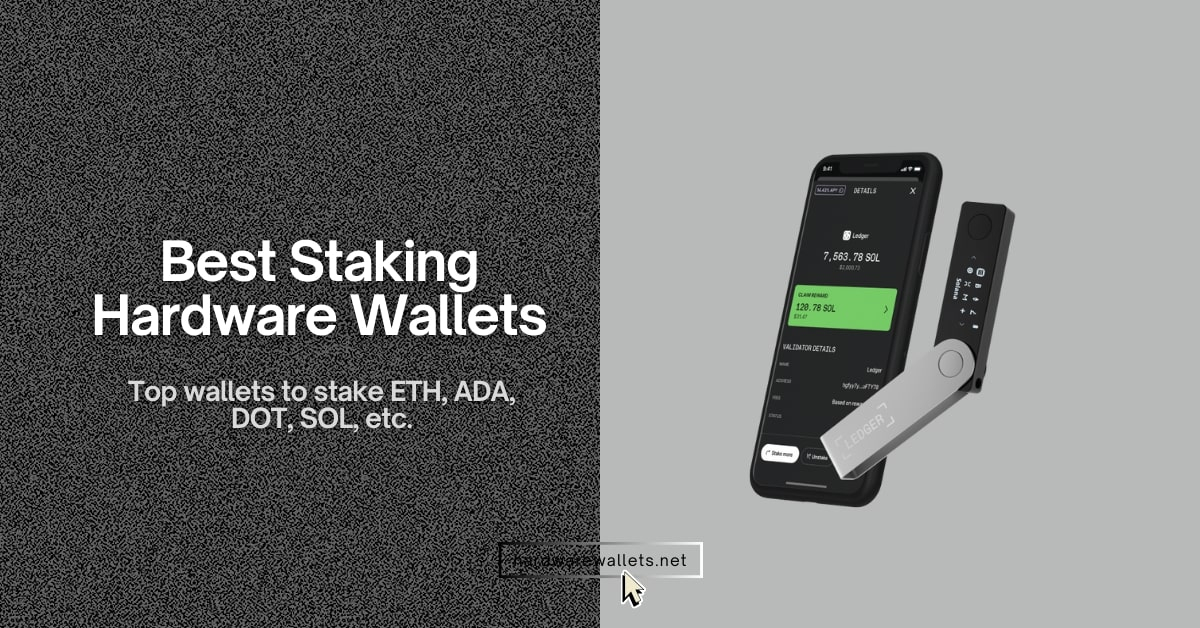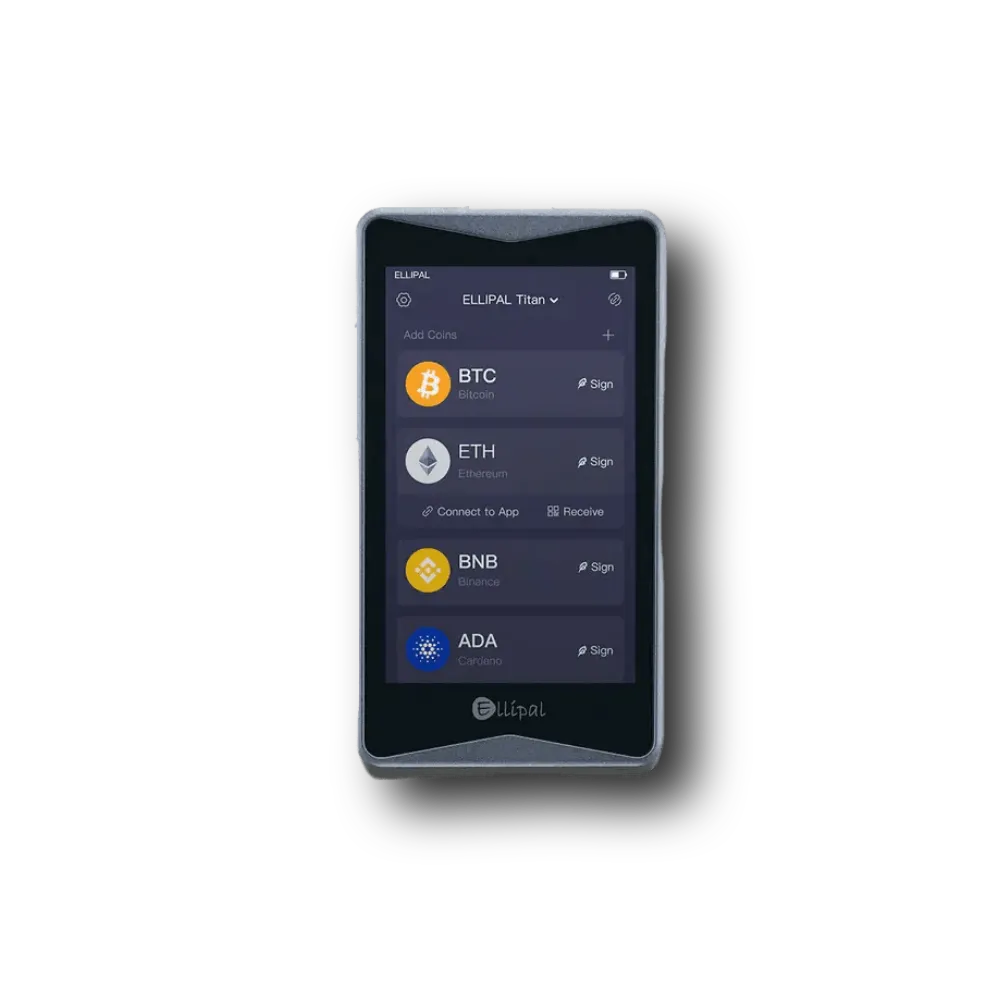Quick summary: The best crypto hardware wallets for staking are Ledger Flex, ELLIPAL Titan 2.0, Trezor Safe 5, Keystone 3 Pro, SafePal S1, and Ledger Nano X due to cold staking, high security, multiple supported coins, and high APY rewards.
You know, exchanges can go down, get hacked, or just decide to freeze withdrawals without warning. So, if you really want to earn staking rewards while sleeping well at night, you actually need to bring your coins offline. That means getting a hardware cold wallet and learning how to stake from it.
This guide will walk you through my honest review of the best crypto hardware wallet for staking coins, focusing on security, rewards, and ease of use.
Table of Contents
Top 6 Best Staking Hardware Wallets 2025
- Ledger Flex: Best hardware wallet for staking overall (Trusted by 7M+ users)
- ELLIPAL Titan 2.0: Best cold wallet for staking (100% air-gapped)
- Trezor Safe 5: Safest hardware wallet for multi-chain staking (open-source security)
- Keystone 3 Pro: Best crypto wallet for staking Altcoins
- SafePal S1 Pro: Most affordable hardware wallet for DeFi staking
- Ledger Nano X: Popular decentralized staking wallet for crypto
The Best Hardware Wallets for Staking: Cold Staking Options for 2025
Here are my recommended 2 best hardware wallets for crypto staking…
1. Ledger Flex: Best crypto hardware wallet for staking overall
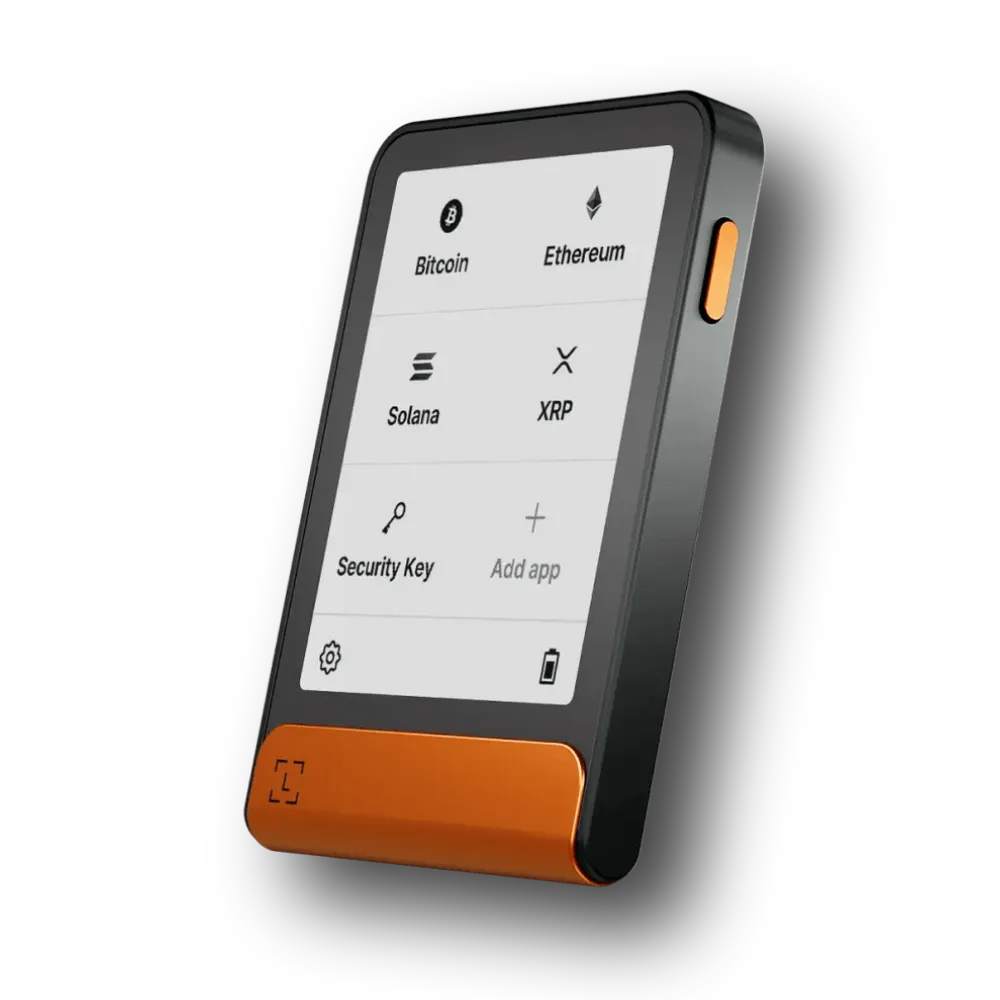
Ledger Flex is the #1 best crypto hardware wallet for staking you can buy right now. It’s the Ledger’s newest model with an e-ink touchscreen display and EAL6+ secure element chip. You can store 15,000+ coins and tokens, and you can install up to 100 different apps at once.
The Flex comes with USB-C, Bluetooth, and NFC connectivity, so you can use it with all your devices, like iPhone, Android, Windows, and MacBook. Now, Ledger supports staking for many popular crypto assets, with both direct delegation and liquid staking options for some tokens. The primary coins you can stake include:
- Cardano (ADA)
- Celo (CELO)
- Cosmos (ATOM)
- Ethereum (ETH) (with multiple options for liquid or pooled staking)
- Near (NEAR)
- Polkadot (DOT)
- Solana (SOL)
- Tezos (XTZ)
- Tron (TRX)
Also, for some assets, or if you prefer more advanced options, Ledger Live even provides access to third-party partners and decentralized finance (DeFi) apps. So, you can stake there too.
Key Features to Know
| Price | $249 |
| Screen | 2.8″ E Ink display (600×480 pixels) with capacitive touch and 16 shades of grey |
| Security | Ledger secure element certified to EAL6+ |
| Connectivity | USB‑C, Bluetooth 5.2, and NFC |
| Weight & size | 57.5 g; dimensions 78.40 × 56.50 × 7.70 mm |
| Unique features | Always‑on lock screen to display NFTs or personal photos; Supports the Ledger Security Key for FIDO2 passkey login |
| Coin support | Over 15,000 coins and tokens via the Ledger Live app |
2. ELLIPAL Titan 2.0: Best cold wallet for staking cryptocurrency
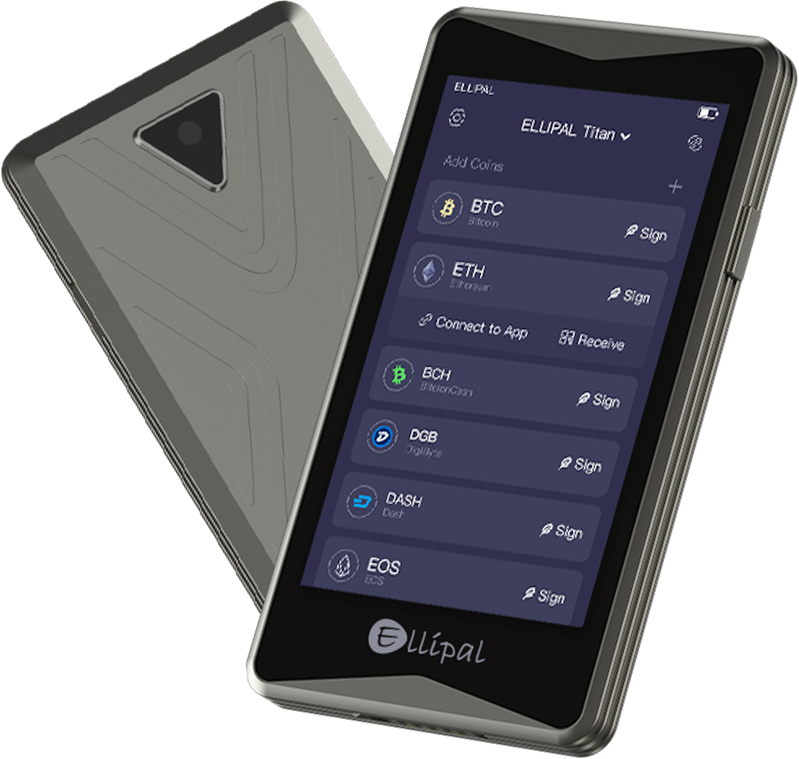
The ELLIPAL Titan 2.0 is an air-gapped hardware wallet for staking, and it is a really safe option for staking altcoins. Basically, air-gapped means the wallet is never, ever connected to the internet or Bluetooth. It uses QR codes to do everything, which is a pretty secure approach. You generally use the camera on the wallet to scan a QR code from the app on your phone to sign a transaction.
The Titan 2.0 and its mobile app support direct staking for the following coins:
- Cardano (ADA)
- Cosmos (ATOM)
- Polkadot (DOT)
- Kusama (KSM)
- Tezos (XTZ)
Now, for Ethereum (ETH) and Solana (SOL), you can use DeFi apps and sign transactions using ELLPAL. The company mainly works with many third-party partners, so you can do DeFi staking through WalletConnect.
Key Features to Know
| Price | $129 |
| Connection method | Air‑gapped; communicates via QR codes only |
| Display | 4-inch colour touchscreen for easy navigation |
| Security | Dual‑layer defence with CC EAL5+ secure chip and metal‑sealed body |
| Coin support | Supports 40+ blockchains and over 10,000 tokens |
| Backup | 24‑word seed phrase; firmware updates via microSD card |
| Unique features | Self‑destruct mechanism and secret secondary wallet |
3. Trezor Safe 5: Safest hardware wallet for multi-chain staking

The Trezor Safe 5 is the latest entry from the pioneer of hardware wallets, I mean, Satoshi Labs. It is best for the open‑source alternative to Ledger. So, out of the box, you get a small but colourful touchscreen, a secure element rated to EAL6+, support for passphrases, and the ability to create multi‑share backups.
Now, talking about staking, Trezor’s approach is mainly through its official software app, Trezor Suite. It’s a desktop and web app that you use with your device. Mainly, you need to connect your Trezor Safe 5, and then you can manage your assets, including staking, right from the app.
The Safe 5 supports staking for:
- Cardano (ADA)
- Ethereum (ETH)
- Solana (SOL)
The Trezor Suite does not include the staking feature for many other Proof-of-Stake (PoS) coins. But by connecting your Trezor Safe 5 to a third-party wallet that is compatible (like MetaMask), you can still safely stake these assets. And, throughout this entire process, your private keys stay securely offline on your Trezor wallet.
Key Features to Know
| Price | $169 |
| Display | 1.54″ color touchscreen with haptic feedback and Gorilla Glass 3 |
| Security | Secure Element chip (EAL6+) plus open‑source firmware |
| Backup | 20‑word wallet backup with microSD multi‑share; supports 12‑, 20‑, and 24‑word seeds |
| Connectivity | USB‑C and microSD card slot; acts as a FIDO2 authentication device |
| Supported coins | 9,000+ coins and tokens via the Trezor Suite app |
| Unique features | FIDO2 passkey, built‑in haptic vibration, and passphrase protection |
4. Keystone 3 Pro: Best crypto wallet for staking Altcoins

Keystone 3 Pro is another cold storage wallet, similar to ELLIPAL Titan. Compared to some other wallets, the 3 Pro does not have an integrated app for staking altcoins. Although it works with many third-party apps, you must connect it to one.
For instance, it is compatible with wallets like Solflare and OKX Wallet and is the official hardware wallet for MetaMask. To be exact, it supports 50+ software wallets for staking and earning rewards. Hence, this lets you access a massive amount of different coins and staking protocols. Basically, if you can find it on a DeFi app or an altcoin-specific wallet, you can probably stake it with the Keystone.
Now, here are some popular stakeable coins supported by the software wallets that are compatible with the Keystone 3 Pro:
- Cosmos (ATOM): Staked through the Keplr Wallet
- Ethereum (ETH): Can be staked via MetaMask using liquid staking services like Lido or Rocket Pool
- Cardano (ADA): Staked using the NuFi wallet
- Solana (SOL): Using the Solflare wallet
- Polkadot (DOT): Can be staked via compatible wallets
- BNB (BNB): Via MetaMask or OKX Web3 Wallet
Key Features to Know
| Price | $149 |
| Air‑gapped transfer | Sign transactions via QR codes and microSD card |
| Security | Three secure‑element chips, fingerprint authentication, and a self‑destruct mechanism |
| Display | 4″ high‑resolution touchscreen for seed management |
| Battery | 1000 mAh removable battery |
| Coin support | Supports Bitcoin‑only firmware and more than 5,000 altcoins on multi‑coin firmware |
| Backup | Shamir backup (multiple seed shares) and dice entropy generation |
5. SafePal S1 Pro: Most affordable hardware wallet for DeFi staking
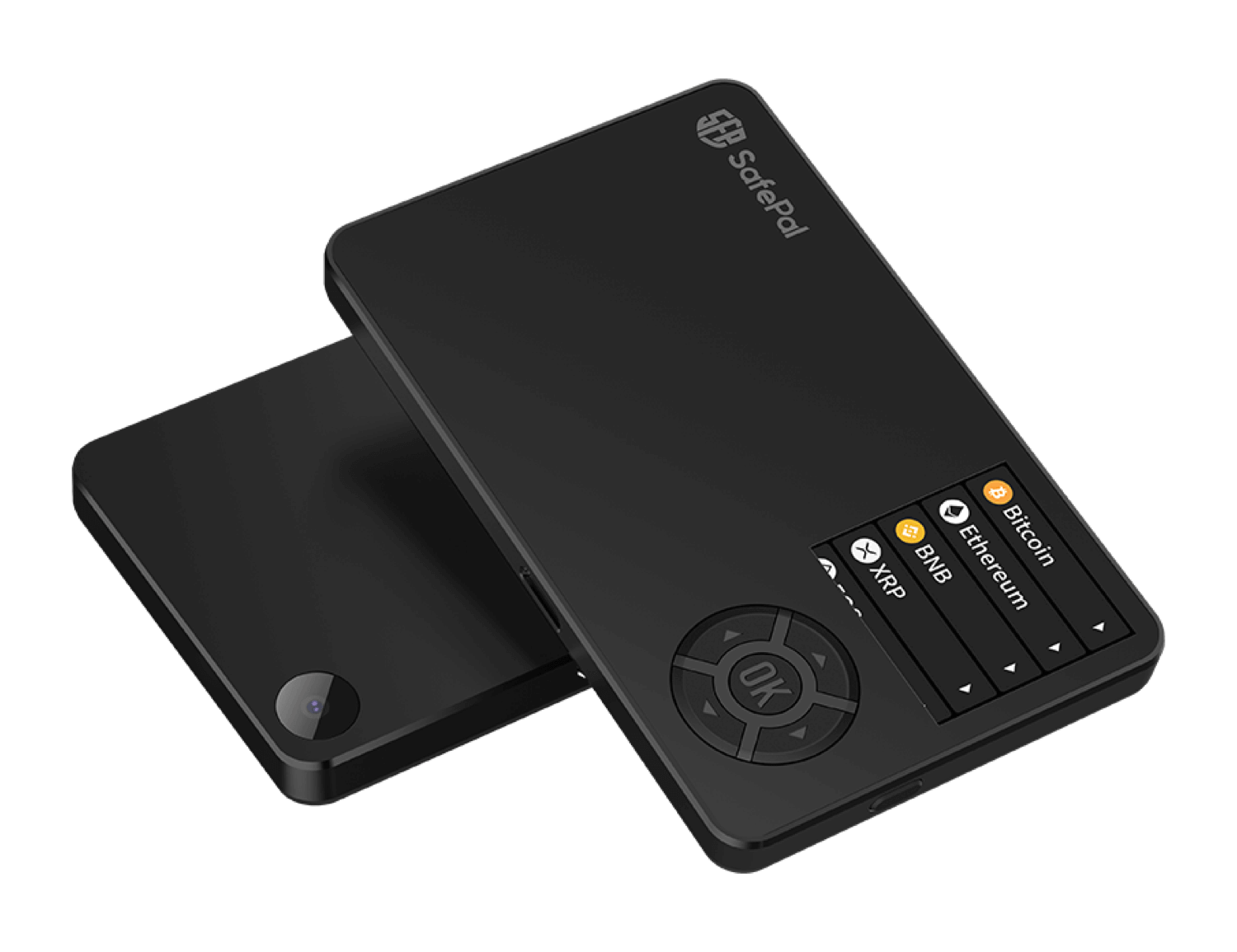
The SafePal S1 Pro is another cold staking device and costs only $69, which is a major selling point. Now, about DeFi staking, it is a real winner because it’s so tightly integrated with the SafePal app. You can access a huge number of DeFi protocols, which is honestly where a lot of the best staking and yield farming opportunities are.
The app has a built-in browser, and it connects to decentralized finance apps like PancakeSwap, Uniswap, and a ton of others. The wallet itself is what you use to confirm transactions, and because it’s air-gapped, you’re always staying safe.
The top supported coins to stake are:
- BNB (SafePal Earn)
- Cardano (SafePal App, though this function may not be available on a desktop interface)
- Cosmos (ATOM)
- Ethereum (Lido Finance)
- Polygon (MATIC): SafePal Earn through a service provider like Stader
- Solana (SOL): Stake SOL directly from the SafePal App through an integrated partner like Kiln
- Tron (TRX)
Key Features to Know
| Price | $69 |
| Connection | 100% offline; no Bluetooth, Wi‑Fi, NFC, or radio; signs via QR codes |
| Body | Premium aluminium alloy with tempered glass front |
| Battery | 500 mAh |
| Security | Anti‑tamper and self‑erasing mechanism; closed system |
| Supported Coins | 10,000+ coins and 100 blockchains |
| Camera | Centre‑mounted for improved QR scanning |
6. Ledger Nano X: Popular decentralized staking wallet for crypto
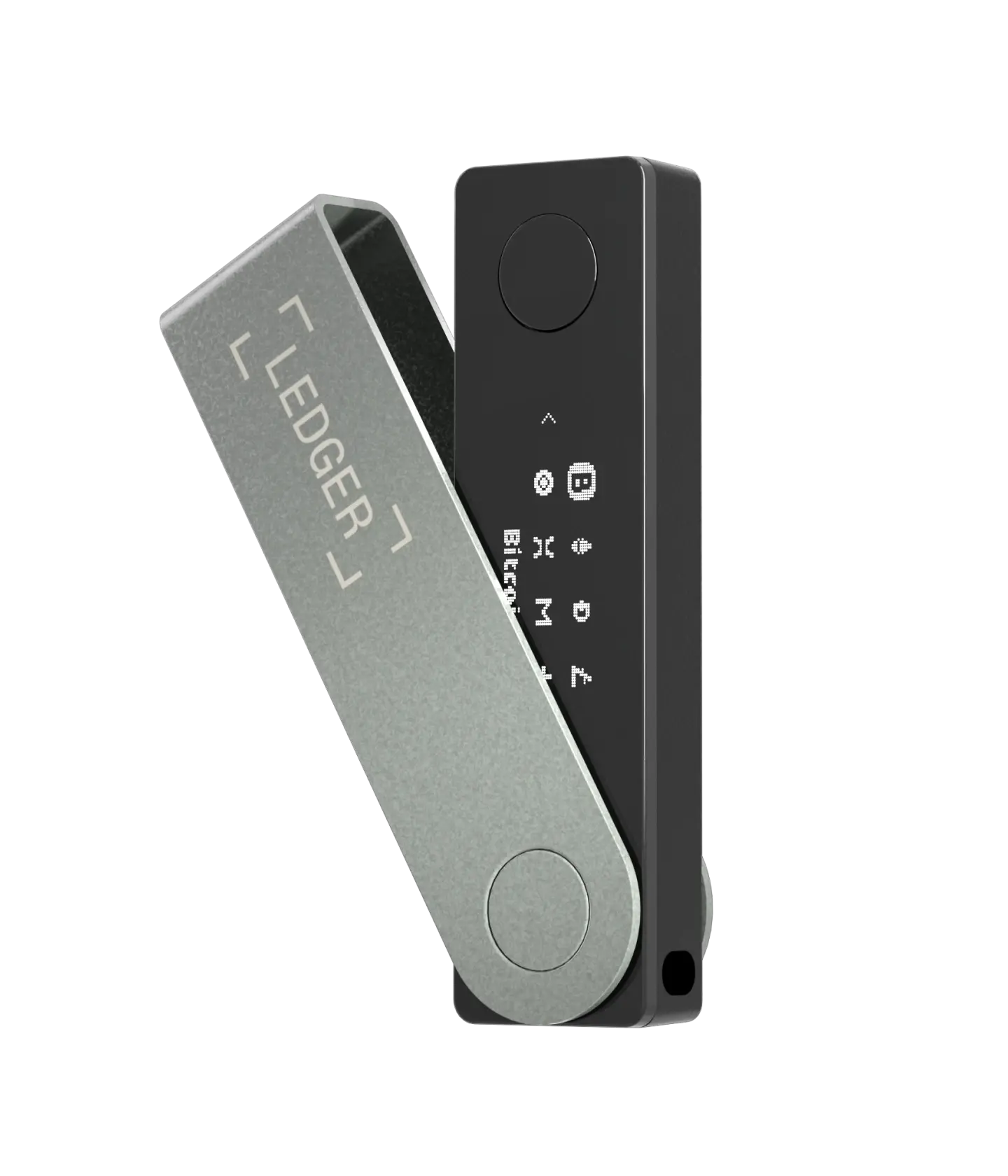
The Ledger Nano X is one of the most well-known hardware wallets out there today, and it’s a really strong choice for anyone who wants to stake crypto. The device itself is pretty small and looks kind of like a USB drive. Mainly, you connect it to your computer or phone using a USB cable or Bluetooth, and then you use the Ledger Live app to manage everything.
Ledger Live app is basically your control center, as you can see your portfolio, send and receive coins, and, of course, stake them. It has native support for staking a bunch of major coins directly, so you can just open the app, go to the “Earn” section, and start staking. The supported assets are:
- Cardano (ADA)
- Cosmos (ATOM)
- Cronos (CRO)
- Ethereum (ETH)
- Polkadot (DOT)
- Solana (SOL)
- Tezos (XTZ)
- Tron (TRX)
Key Features to Know
| Price | $149 |
| Security chip | Secure element (EAL5+) protects private keys |
| Connectivity | USB‑C and Bluetooth; works with iOS, Android, and desktop |
| Display | 1.09-inch monochrome OLED with two buttons |
| Coin support | 15,000+ supported coins, Ethereum, and Polygon NFTs |
| Battery life | Around five hours of active use, Weeks in standby |
Comparing Top Hardware Crypto Wallets for Staking
Now, let’s compare these best hardware wallets for staking based on their features side-by-side for a better understanding:
| Staking Wallet | Native staking coins | Total coin support | Connectivity | Price |
|---|---|---|---|---|
| Ledger Flex | Ethereum, Solana, Cosmos, Polkadot, Algorand, Tron | 15,000+ | Bluetooth, NFC, and USB‑C | $249 |
| Ellipal Titan 2.0 | Ethereum, Cosmos, Polkadot, Tezos | 10,000+ | QR codes only | $129 |
| Trezor Safe 5 | Ethereum, Cardano | 9,000+ | USB‑C; no battery | $169 |
| Keystone 3 Pro | None (third‑party only) | 5,500+ | QR code and microSD; 1,000 mAh battery | $149 |
| SafePal S1 Pro | SafePal token, Ethereum, and several others via SafePal Earn | 30,000+ | QR code; 500 mAh battery | $69 |
| Ledger Nano X | Same as the Flex | 15,000+ | Bluetooth 5.2 and USB‑C | $149 |
What is Crypto Staking?
Staking, to put it simply, is how proof-of-stake blockchains secure themselves. Here, crypto validators use their own coins as collateral rather than burning electricity like Bitcoin miners do, and validators are mainly chosen at random by the network to propose and attest to blocks. Later, they are rewarded with new coins in exchange.
Hence, when you stake, you give a validator access to your tokens so they can take part on your behalf. You receive a portion of the profits and maintain custody of your coins in your hardware wallet.
So, why would you bother to stake? Because the yields can be attractive. Earning 4-10% APY is a nice bonus if you already plan to hold a coin, and staking also contributes to network security.
Staking rewards comparison across popular hard wallets
| Hardware Wallet | Ethereum (ETH) | Solana (SOL) | Cardano (ADA) | Polkadot (DOT) |
| Ledger Nano X / Ledger Flex | 3% – 5% (via Ledger Live partners like Lido) | Around 5% (via Ledger Live) | Around 2% – 5% (via third-party wallets like Yoroi) | 9% – 13% (via Ledger Live) |
| ELLIPAL Titan 2.0 | 3% – 5% (via WalletConnect with dApps) | Around 5% (via WalletConnect) | Around 2% – 5% (via third-party wallets) | 9% – 13% (via third-party wallets) |
| Trezor Safe 5 | 3% – 5% (via Trezor Suite partners) | Around 5% (via Trezor Suite) | 2% – 5% (via Trezor Suite) | 9% – 13% (via third-party wallets) |
| Keystone 3 Pro | 3% – 5% (via WalletConnect with MetaMask) | Around 5% (via Solflare or other wallets) | 2% – 5% (via Yoroi or other wallets) | 9% – 13% (via a third-party wallet) |
| SafePal S1 Pro | 3% – 5% (via SafePal app) | Around 5% (via SafePal app) | 2% – 5% (via SafePal app) | 9% – 13% (via SafePal app) |
How to Stake Crypto Using a Hardware Wallet (Using Ledger)?
Let me show you how to stake Cardano using Ledger hardware wallet…
- First off, plug your Ledger device into your computer. Next, open up the Ledger Live application on your computer.
- Once you’re in the app, head over to the Accounts section, find your Cardano (ADA) account, and click on it. Now, when you’re in the account details, just hit the “Stake” button.
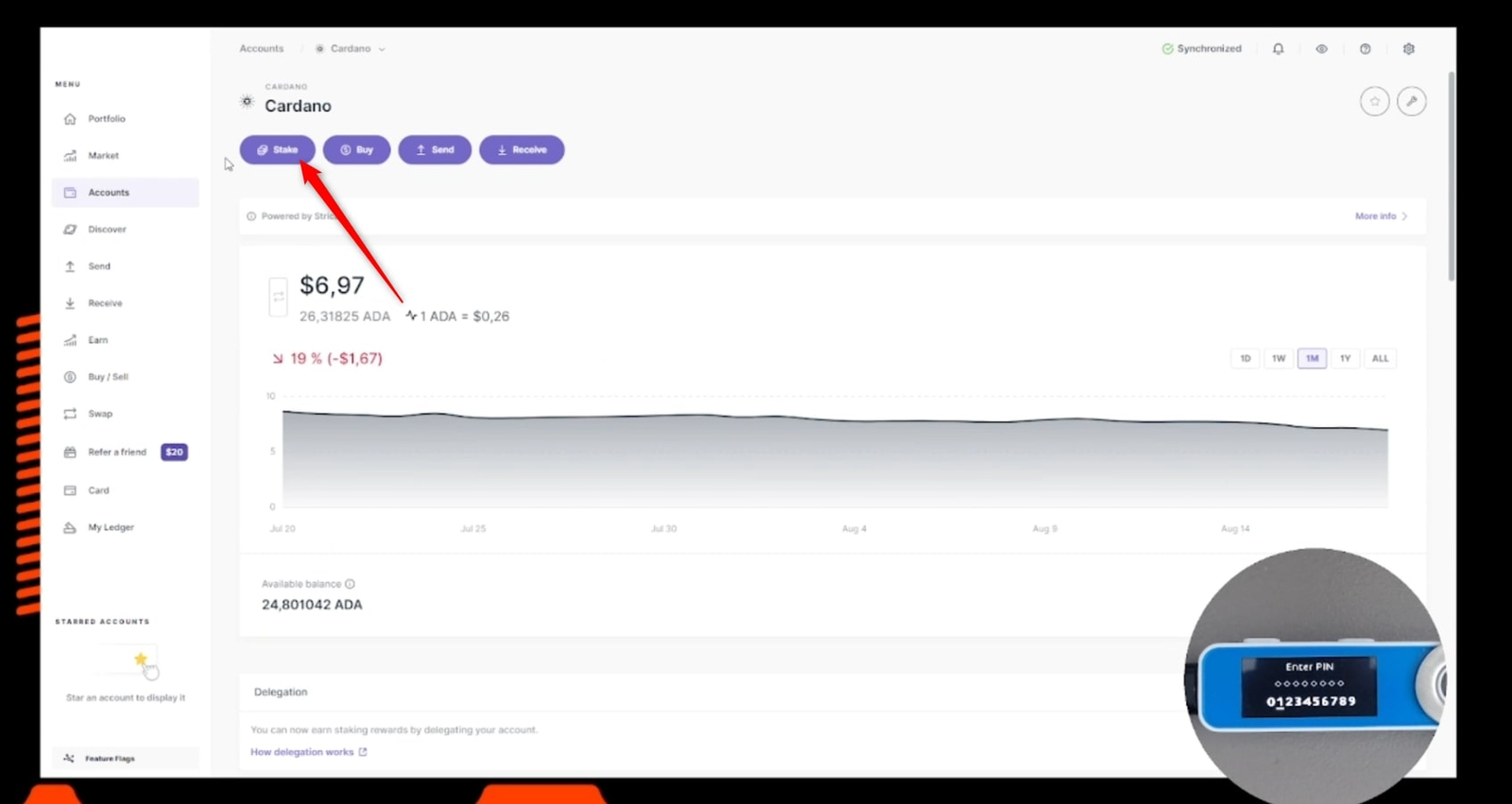
- You need to choose “Ledger by Figment” as your validator, then click Continue. Also, if you prefer, you can pick a different one instead.
- Now, review all the transaction details and click Continue.
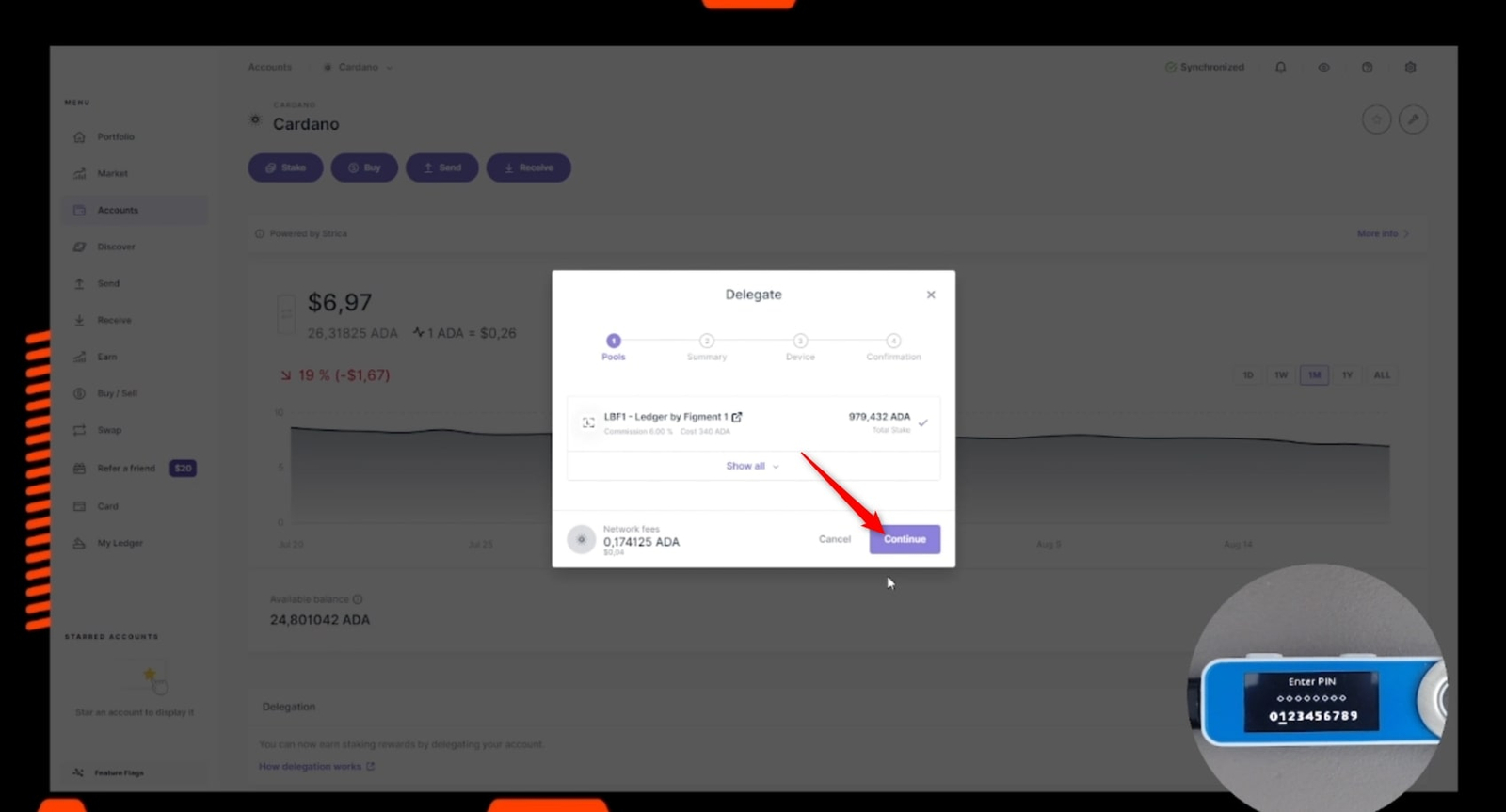
- Next, unlock your Ledger device, then open up the Cardano ADA app on it. Now, you’ll need to double-check the staking transaction on your Ledger.
- If everything looks correct, go to the screen that says “Confirm transaction.” To finish up, just press both buttons at the same time. That will sign the transaction and send it out, starting your Cardano (ADA) delegation.
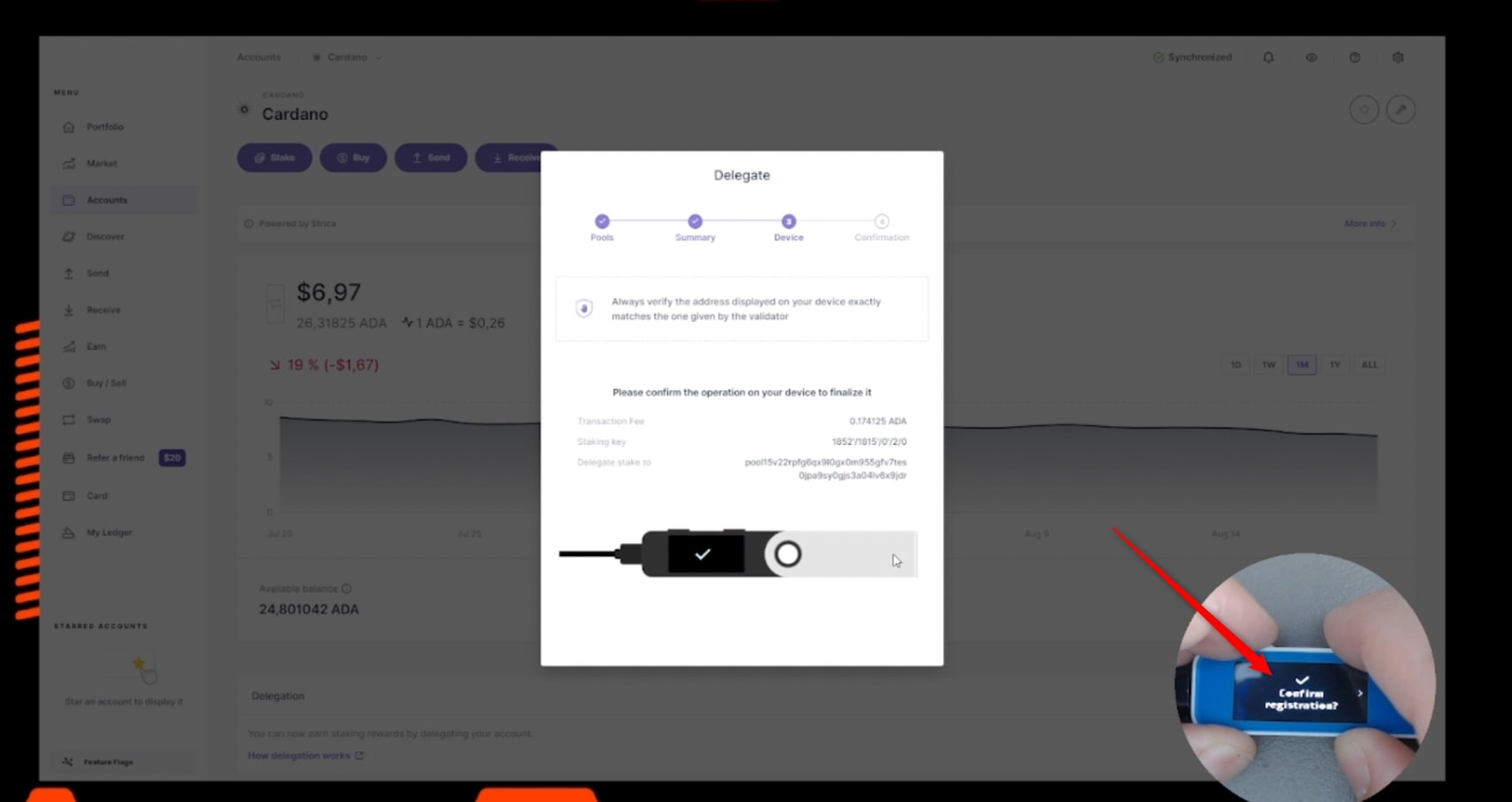
How to Choose the Right Hardware Wallet for Multi-Coin Staking?
To choose the right hardware wallet for staking, you need to consider factors such as security features, supported coins to stake, staking methods, user experience, and hardware cost.
- Security Model: You must consider the wallet’s actual functioning. As discussed, some are completely air-gapped, such as the Keystone or ELLIPAL. So, this indicates that they never use the internet and sign transactions using extremely safe QR codes. Others, such as the Trezor or Ledger, connect via Bluetooth or a cable. They still use a unique chip inside to keep your keys safe, which is excellent.
- Supported Coins & Staking Methods: You need to check if the wallet’s official app actually supports staking for the coins you want. You know, a lot of wallets will say they support thousands of coins for storage, but staking is a whole other thing. So, for example, some hardware wallets let you stake right in their app, which is pretty easy, whereas others make you connect to a third-party app like MetaMask to do it.
- User Experience: Honestly, how the wallet feels in your hand matters a lot. A big, clear touchscreen, like on the ELLIPAL 2.0, can make confirming transactions way easier. But a tiny screen with small buttons can get kind of annoying, especially if you’re a heavy staker. Remember, you’ll be using this thing a lot, so you want to be happy with it.
- Cost and Value: You don’t have to spend a fortune to get a good, secure, and best hardware wallet for staking. The SafePal S1 Pro, for example, gives you a ton of security features for a much lower price. So, the more expensive wallets might have a better screen or some extra features, but you have to decide if that extra stuff is really worth the money for you.
Native vs. third-party staking support in hardware wallets
Native staking means the hardware wallet’s own software handles everything. Ledger Live, Trezor Suite, Ellipal Earn, and SafePal Earn are examples. The benefits are obvious: the interface is simple, you don’t have to approve random smart contracts, and it’s harder to fall for phishing scams.
Third‑party staking involves connecting your hardware wallet to an external wallet or dApp. So, say, you can use MetaMask, Keplr, Phantom, or a dedicated staking portal. Hence, you unlock far more options. You can stake lesser‑known tokens, use liquid staking protocols like Lido, or even restake your ETH on new projects.
| Criteria | Native Staking | Third-Party Staking |
|---|---|---|
| Control | Full control | Shared control |
| Security | Lower risk | Higher risk |
| Fees | Lower | Higher |
| Ease of Use | Complex | Simple |
| Asset Support | Limited | Wide |
| Lock-Up | Fixed | Flexible |
| Validator Choice | Full choice | Limited |
| Rewards | Higher | Slightly lower |
| Maintenance | Manual | Managed |
Related FAQs
What is the safest hardware wallet for staking Ethereum?
The safest hardware wallets for staking Ethereum are the ones with a proven security record and good third-party integrations, like the Ledger Flex and Nano X.
Basically, Ledger has a secure chip that keeps your private keys offline, and you can use their Ledger Live app to connect to staking partners like Lido to stake your ETH. Hence, the important thing is that your private keys never leave the device, so you’re not at risk of them being stolen online.
Can I stake Solana using a Ledger Nano X?
Yes, you can totally stake Solana using a Ledger Nano X. Actually, you can do this right inside the Ledger Live app, and also, you don’t have to go to a separate website. You just open your Solana account, choose to stake, and then you pick a validator.
Which is the top wallet for Polkadot staking?
The Ledger Nano X and ELLIPAL Titan 2.0 are the best hardware wallets for Polkdot (DOT) staking because they can be used with wallets like Nova Wallet.
While you can do some staking in Ledger Live as well, using a wallet that’s made just for Polkadot gives you some more options, just like being able to vote on network stuff.
Read my full guide on the best Polkadot wallets…
How does cold staking work with hardware wallets?
Cold staking works by keeping your crypto in a hardware wallet that is not connected to the internet, and then you delegate it to a validator. Here, your coins never actually leave your wallet, and your private keys stay offline.
You basically send a transaction from your hardware wallet that says, “I want to delegate my coins to this specific validator.” Now, the validator then uses your coins to help secure the network and earn rewards for you, but they can’t actually spend your coins or take them. Read my in-depth guide on the best cold storage wallets.
Which hardware wallet supports staking multiple coins or cross-chain staking?
Ledger Flex/Nano X, Trezor, ELLIPAL, Keystone, and SafePal are the top hardware wallets that support staking multiple assets. Mainly, for cross-chain staking or multi-coin staking, you need to connect your wallet to third-party DeFi apps.
Is staking with Trezor Model T secure?
Yes, the older Trezor Model T is still secure for what it offers, but it lacks a secure element. Mainly, it relies solely on its open‑source firmware and the physical design of the microcontroller.
So, that’s fine for many users, but the newer Safe 5 adds a high‑assurance chip, which increases protection against certain hardware attacks.
What are the staking rewards for Cardano on Ledger Live?
The staking rewards for Cardano (ADA) on Ledger Live are usually around 2% to 5% a year. You know, the exact number changes depending on what’s happening on the network, but you easily can stake your entire ADA balance, and the rewards get added to your account every 5 days or so.
Can I use MetaMask with a hardware wallet for staking?
Yes, you can absolutely use MetaMask with a hardware wallet for staking. You just connect your hardware wallet, like a Ledger or Trezor, to MetaMask.
Basically, this turns MetaMask into a secure gateway, so your private keys stay on the hardware wallet, but you can use MetaMask’s interface to connect to different DeFi platforms and stake your crypto.
What’s the difference between hot and cold staking wallets?
A hot wallet is any wallet connected to the internet. Exchanges, web wallets, and browser extensions like MetaMask are actually hot.
A cold wallet is offline, so you only need to connect it to sign transactions. Cold staking means you delegate your coins while keeping the keys on an offline device.
Do hardware wallets support DeFi staking protocols?
Yes, hardware wallets totally support DeFi staking protocols. They do this by connecting to third-party apps and dApps using things like WalletConnect. Hence, this allows you to get into all sorts of DeFi staking and yield farming opportunities.
You can also read my other articles, like the best hardware wallet for NFTs and the best hardware wallets for MetaMask.
